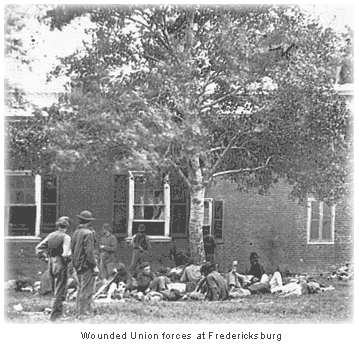Following McClellan’s failure to follow up after Antietam, President Lincoln turned to General Ambrose E. Burnside. The Union army, some 113,000 strong, sought out the Confederate forces in the Virginia town of Fredericksburg on the Rappahannock River. Lee had taken a position in the heavily wooded hills outside of the community.
On December 13, wave after wave of Union soldiers threw themselves against the deeply entrenched Confederate lines. The toll was tremendous with Burnside absorbing more than 12,000 casualties, and Lee less than half that number. The Union forces withdrew and Burnside asked to be relieved of his command; Lincoln consented.
 The opposing armies spent the winter of 1862-63 on opposite sides of the Rappahannock River.
The loss at Fredericksburg was a matter of grave concern in the North, especially when many believed that a final victory had been so close at Antietam. Northern weakness was noted not only in the South, but also in Europe. French forces, realizing the Monroe Doctrine would not be enforced, took Mexico City several months later.
The opposing armies spent the winter of 1862-63 on opposite sides of the Rappahannock River.
The loss at Fredericksburg was a matter of grave concern in the North, especially when many believed that a final victory had been so close at Antietam. Northern weakness was noted not only in the South, but also in Europe. French forces, realizing the Monroe Doctrine would not be enforced, took Mexico City several months later.